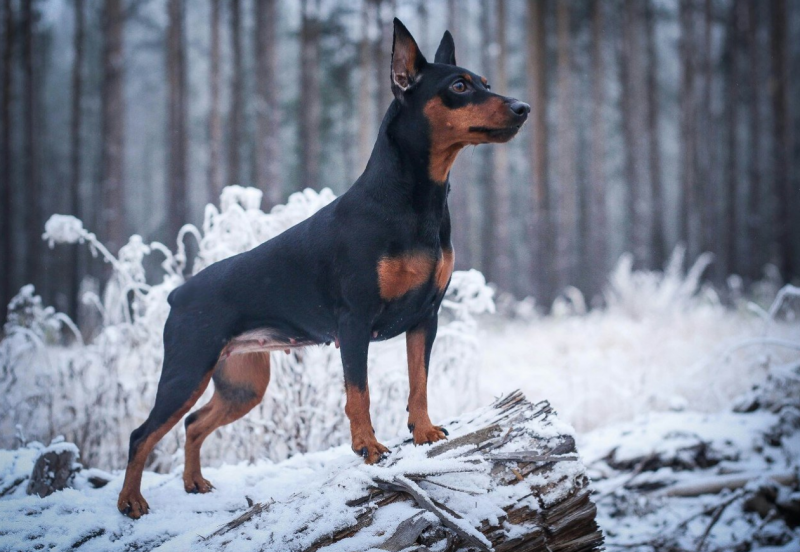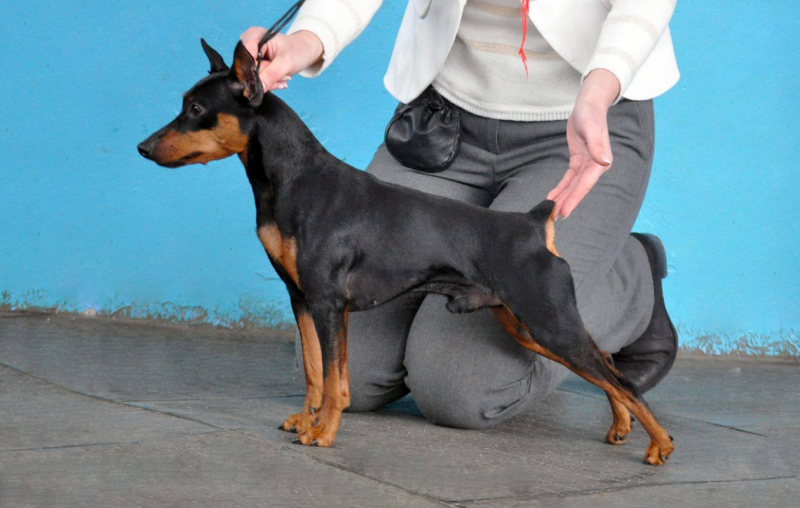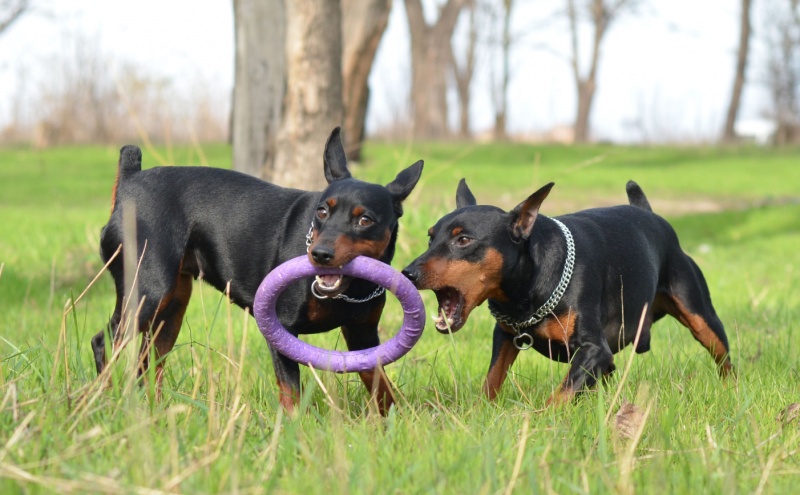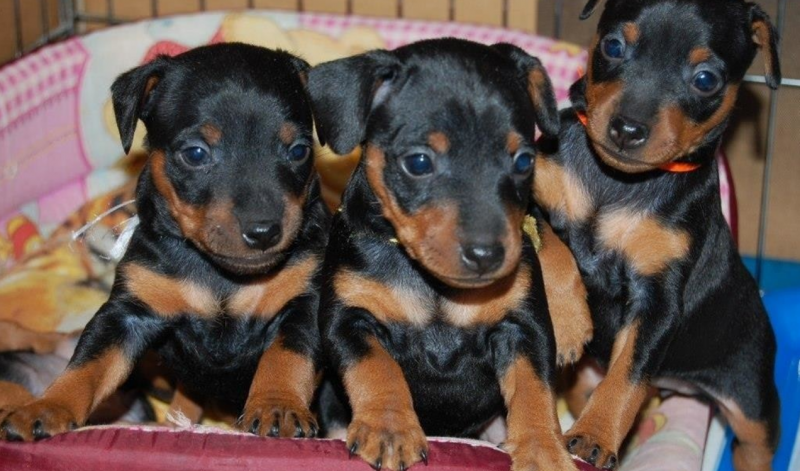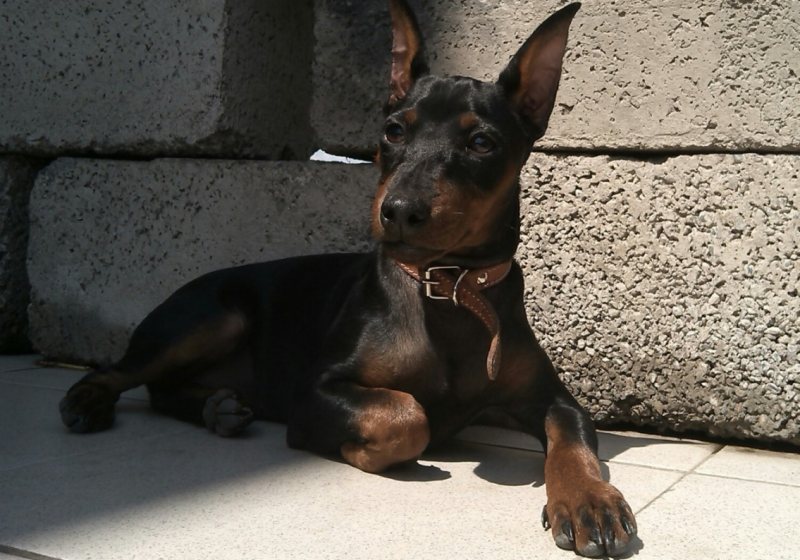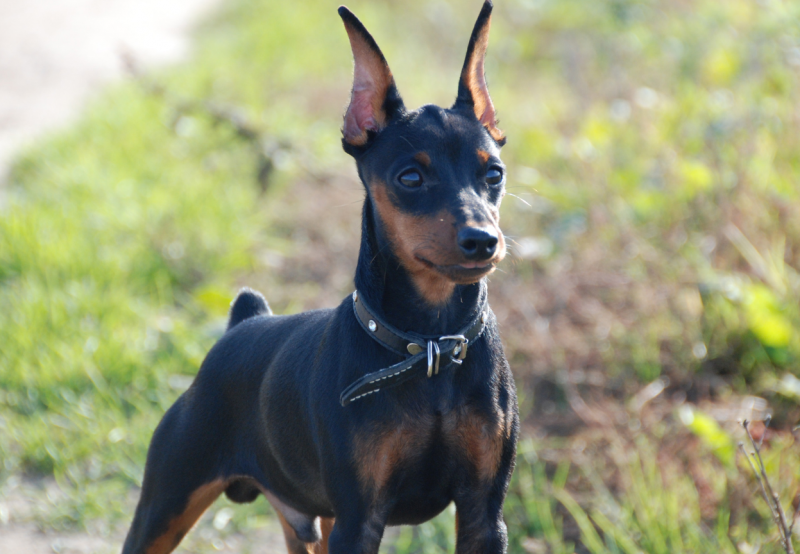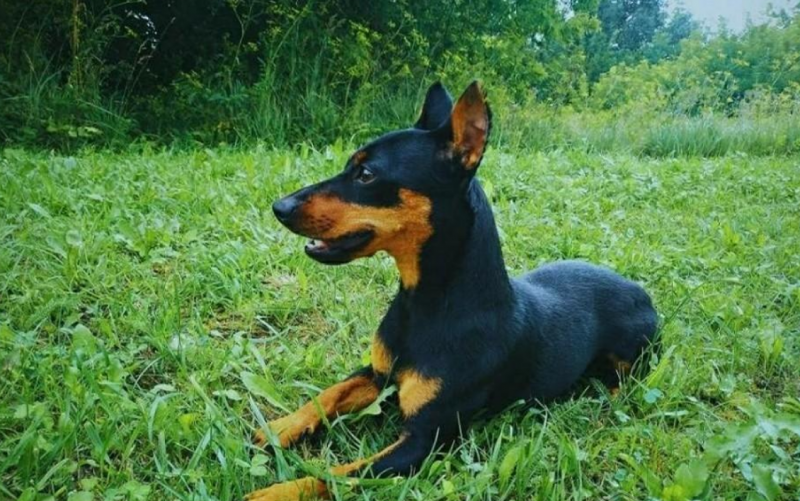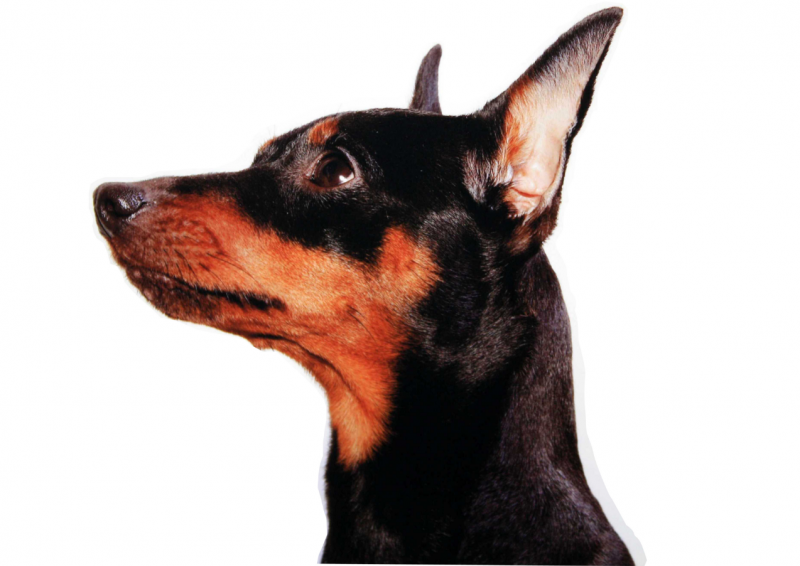Tall, graceful and lean Dobermans are unlikely to leave anyone indifferent. But not everyone knows about the existence of a "younger brother" of these animals - a mini-Doberman. What is special about the representatives of this breed, and how to care for miniature creatures?
Material Content:
Description and character of the miniature pinscher
What is the name of the mini-Doberman in alternative variations?
These charming creatures are also called miniature pinschers (from German “miniature” - gnome, dwarf). Given the small size of the animal, this name is quite suitable for him.
Description of the miniature pinscher breed is appropriate to start with the main features of these animals - their size. The weight of these creatures does not exceed 6 kg, height - 45 cm at the withers. But, despite these truly toy dimensions, the animal looks quite muscular and strong. At the same time, the miniature pinscher, like his closest relative Doberman, is distinguished by grace, amazing grace and dexterity.
The body of the zerg is harmoniously folded, the head of the dog is slightly elongated. Oval eyes of deep brown or black color give the appearance of animals notes of playfulness and even tenderness.
The shape of the ears of the little Pinchers only strengthens their resemblance to the Dobermans, as does the graceful neck.
The color of miniature dogs is usually dark brown or black and tan on the face and stomach, which gives the Zwergpinscher some masculinity and solidity.
If the miniature pinscher is acquired for an exhibition career, then he still having to be a puppy (up to 4 months) will have to transfer the stopping of the ears and tail.Cropped ears as a result take the shape of a standing candle. Usually, tsvergs easily tolerate this operation, and the rehabilitation period does not take much time and is not accompanied by any complications. Make stopping should be done exclusively by a specialist.
Miniature pinschers, without regard to modest sizes, are animals hardy and strong. Their inherent qualities as hunters can frighten even larger individuals, the size of which exceeds the zerg.
Little Pinschers are very loyal to the owner and home and are friendly to other family members, as well as pets.
History of breed origin
Dwarf pinschers were first mentioned around the 15th century.
According to the records of long-standing archives, the German town of Württemberg, famous for its numerous farms breeding horses, is considered to be the birthplace of a dwarf pincher dog. It is interesting that it was the owners of stagecoaches that the little pinchers were especially popular. It was caused not only by the appearance of the dogs - the miniature pinschers did an excellent job of catching rats, abundantly found on farms.
In the 19th century, breeders began to modify this dwarf dog breed. A new, “improved” miniature pinscher presented to exhibitions in 1878
Puppy selection criteria
Choosing a miniature pinscher puppy, you need to observe the following features of the animal:
- Behavior. Little zwerg must be curious and active.
- Appearance of the parent. Mom puppies should look well-groomed, well-fed. Most likely, her children will be the same.
- The condition of the teeth and bite. The latter must be correct.
- The condition of the coat, eyes and mucous membranes. They must be clean and healthy.
- The condition of the coat. The Doberman coat should also be in perfect condition - smooth, shiny, without bald spots.
Tip. The potential owner should not worry if he sees scratches on the puppy's hair. Having played, kids can scratch each other, this phenomenon is considered quite normal.
Puppies are best transported for 2 to 3 months, so they should be purchased during this period. The price for one baby varies from 10 to 30 thousand rubles. The cost is due to a number of factors, including: the presence of a pedigree, tribal marriage, etc.
Note. The Zwergpinscher breed standard assumes for babies an exclusively uncocked tail, which takes the form of a saber or sickle. Its shortening occurs a little later, if the dog is preparing for the exhibition.
Keeping and caring for a dog
Small miniature pinschers are unpretentious and do not require special care.
- Kids can comb out a couple of times a week, and in most cases it’s enough to use a damp cloth to wipe the fur coat.
- Docked tail also does not require special care.
- Twice a year, you can trim, allowing you to remove old hairs from the surface of the wool.
- You should also regularly trim the growing claws, using a special tool for this.
- Bathing small pinchers should be once every six months.
Due to their size, dogs Tsverghs do not need a lot of space, so they are well acclimatized in a private house and in an apartment. Walk with a dwarf pincher should be at least 2 times a day.
Tip. The owners of the miniature pinscher should protect their pets from colds and drafts. For walks in the cold season, you need to stock up with special boots and overalls for the pet.
Diet and diet
Zverg has a great appetite since childhood, but this does not mean that they need large amounts of food. It is useful to feed a doggie with warm milk, boiled vegetables, chicken, cottage cheese, cereals in milk. It is permissible to include beef in the diet of an adult (in crushed form, it can be added to porridge).
Adequate vegetables help to improve the digestive system of small pinchers.Regardless of the choice of diet (natural food or prepared food), the menu should include a sufficient amount of calcium and vitamins.
It is better to choose ready-made feeds marked “premium class”; you can opt for products designed specifically for small dogs. Feed the puppy up to a year should be 3 - 4 times a day, an adult - twice a day
Attention. Dwarf pinchers are animals prone to obesity.
The owner should carefully monitor the pet’s diet and not treat him with treats from his table, as well as ensure maximum physical load of the crumbs.
How to train and educate
Miniature Pinschers are extremely energetic and confident dogs. Their distinguishing feature is the passion for dominance and leadership. It is a mistake to assume that these babies can be left without proper education and training. By choosing the right approach to the little pincher, the owner will be able to reveal all the positive qualities of his character and smooth out the sharp corners in his behavior.
Bringing the puppy to the house, you should immediately identify the rules of conduct in the home. Of course, in 1 day, the baby is unlikely to learn to sleep in a certain place and walk in need wherever the owner orders. Nevertheless, explaining to the dog what is possible and what is not, should be started as early as possible.
Indulging the whims of the tsverg is nothing but a manifestation of weakness. This approach will make the doggie a manipulator.
When training a Pincher puppy, you need to pursue the following goals:
- accustoming to the place and nickname;
- phased accustoming to street need;
- familiarization with the collar and leash;
- taboo on raising food from the ground (floor);
- Ability to respond to the command "Come to me!"
- socialization of the dog.
The most successful age from the point of view of training is 4 months. From this moment, the dog begins to show character, checking the owner for strength. The owners of the growing zerg are faced with all sorts of tricks of the crumbs - disobedience, escapes, damage to property, etc. Training a pet will help him understand who the leader of the pack is and will make the dog a discipline. It is best to conduct classes in the form of a game and to encourage the baby for his success in learning.
Tip. If the owner understands that he is not coping with the education of the tsverg, he should seek help from a canine specialist. Classes in a group with dogs of about the same age and level of training, adjusted by a specialist, can speed up the process.
Miniature Doberman Activity
The dog breed miniature pinscher is playful and active. That is why the owner of a small pet should give him the opportunity to move more. The ideal type of activity for these creatures is agility and walks in open areas, where the miniature can frolic freely without a leash. In this case, the owner should be careful not to allow the pinscher to meet with other animals, since this brave baby is able to fight with larger and stronger dogs than himself.
You can start walking Pincher puppies after vaccinations and the quarantine that followed them. When making an alley, several recommendations should be considered:
- The duration of the boardwalks should not exceed 1 hour.
- It is best to choose squares and parks for walking.
- The leash on which the miniature pinscher walks should be long enough.
The owner must make sure that during the walk the pet is tired - so he will not have time to naughty in the home.
If, after walking, the miniature is resting or sleeping, the duration of the walk should not be increased. If the baby’s activity does not subside even after a walk, the duration of the promenade can be increased.
Characteristic breed diseases
In general, dwarf pinschers are considered to be a healthy breed of dogs, but are nevertheless disposed towards the following diseases:
- cataract, glaucoma;
- retinal degeneration;
- dislocation of the shoulder;
- diabetes mellitus;
- urolithiasis.
The weak point of the zerg is a short coat, unable to protect the dog from the cold. If the temperature is not observed, dogs can catch a cold and get sick.
Pros and cons of the dwarf pincher
The dwarf pinscher is appreciated by the owners for a number of positive qualities, namely:
- Zvergs are ideal for keeping even in small rooms;
- good health, lack of serious hereditary pathologies;
- stamina - the pet is able to accompany the owner everywhere;
- excellent sense of smell and hearing;
- lack of undercoat (very important for allergic owners);
- ease in hair care, rare molting;
- lack of a specific "dog" smell;
- devotion to the owner;
- the ability to get along with pets;
- lack of pickiness in food;
- ability to accustom to the tray.
Small Dobermans, despite their small size, are valued as excellent guards.
Of the minuses of the breed are:
- excessive activity, and sometimes hyperactivity;
- irascible temper and arrogance;
- excessively loud barking;
- obstinacy, self-will, propensity to dominate;
- dislike for loneliness (left to their own devices, the tsvergs can begin to play and spoil furniture, shoes and other items).
People who plant zerg in a house with a garden should take into account the love of these animals to dig in the ground. Therefore, freshly planted beds and flower beds can be exposed to real danger posed by a miniature Pied Piper.


